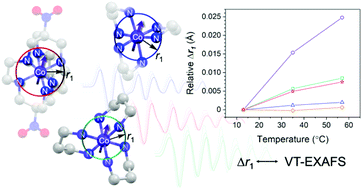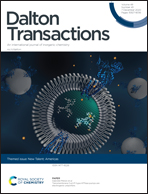EXAFS investigations of temperature-dependent structure in cobalt-59 molecular NMR thermometers†
Abstract
Cobalt-59 nuclei are known for extremely thermally sensitive chemical shifts (δ), which in the long term could yield novel magnetic resonance thermometers for bioimaging applications. In this manuscript, we apply extended X-ray absorption fine structure (EXAFS) spectroscopy for the first time to probe the exact variations in physical structure that produce the exceptional thermal sensitivity of the 59Co NMR chemical shift. We apply this spectroscopic technique to five Co(III) complexes: [Co(NH3)6]Cl3 (1), [Co(en)3]Cl3 (2) (en = ethylenediamine), [Co(tn)3]Cl3 (3) (tn = trimethylenediamine), [Co(tame)2]Cl3 (4) (tame = 1,1,1-tris(aminomethyl)ethane), and [Co(diNOsar)]Cl3 (5) (diNOsar = dinitrosarcophagine). The solution-phase EXAFS data reveal increasing Co–N bond distances for these aqueous complexes over a ∼50 °C temperature window, expanding by Δr(Co–N) = 0.0256(6) Å, 0.0020(5) Å, 0.0084(5) Å, 0.0006(5) Å, and 0.0075(6) Å for 1–5, respectively. Computational analyses of the structural changes reveal that increased connectivity between the donor atoms encourages complex structural variations. These results imply that rich temperature-dependent structural variations define 59Co NMR thermometry in macrocyclic complexes.

- This article is part of the themed collection: New Talent: Americas


 Please wait while we load your content...
Please wait while we load your content...